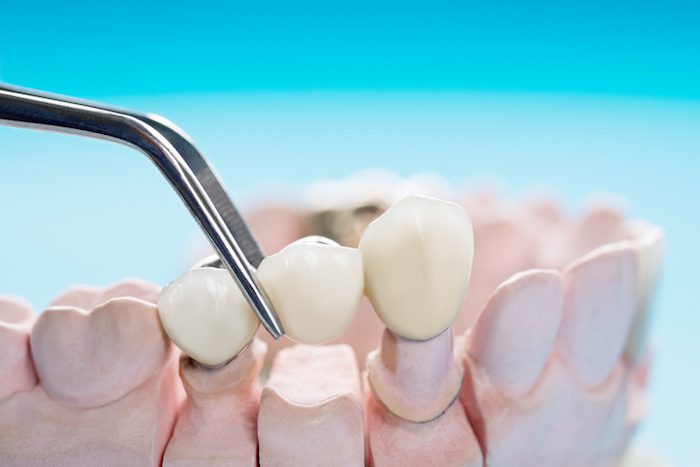Replacing missing teeth is an essential part of maintaining your oral health. Mill Creek Dental uses dental bridges to replace multiple consecutive missing teeth. Restorative dental services like dental bridges restore the full functionality of your smile and give you confidence again.


Dental Bridges in Canton, TX
A dental bridge is a fixed appliance used to replace one or more missing teeth. It consists of one or more artificial teeth, called pontics, anchored in place by crowns on the adjacent natural teeth or implants. The bridge literally “bridges” the gap left by the missing teeth, restoring function and appearance.
Types of Dental Bridges
There are a few different types of dental bridges, each designed to meet specific needs. Here’s a quick look at the main types:
-
Traditional Bridge: This is the most common type. It involves placing crowns on the natural teeth next to the gap and attaching the artificial tooth or teeth between them.
-
Cantilever Bridge: This type of bridge is used when natural teeth are present on only one side of the gap. The bridge is anchored on just one side, which is helpful in certain situations.
-
Maryland Bridge: This type uses a metal or porcelain framework that attaches to the back of the adjacent teeth. It’s less invasive than traditional bridges and is often used for front teeth.
-
Implant-Supported Bridge: This bridge is anchored by dental implants rather than crowns on natural teeth. It’s used when several teeth are missing or when no natural teeth are available for support.
The Dental Bridge Process
During your first visit, your dentist will examine your teeth and gums to determine if a dental bridge is right for you. They will take X-rays and possibly make impressions of your mouth to plan the treatment.
If you’re getting a traditional bridge, the next step is to prepare the adjacent teeth. The dentist will file down these teeth to make room for the crowns holding the bridge in place. If you’re getting an implant-supported bridge, the dentist will place the dental implants into your jawbone.
After preparing the teeth or placing the implants, your dentist will take impressions of your mouth. These impressions are sent to a dental lab, where your custom bridge is made. In the meantime, you may receive a temporary bridge to protect your prepared teeth.
Once your permanent bridge is ready, you’ll return to the dentist’s office to have it fitted. The dentist will check the fit and make any necessary adjustments to ensure the bridge fits comfortably and looks natural. After ensuring everything fits properly, the dentist will cement the bridge. They will provide you with care instructions and schedule follow-up visits to ensure everything is working well.
Benefits of Dental Bridges
Dental bridges offer several benefits, including:
- Restored Function: Bridges help you chew and speak normally by filling in the gaps left by missing teeth. This can improve your ability to enjoy your favorite foods and communicate clearly.
- Improved Appearance: A dental bridge can restore the natural shape of your smile and improve your overall appearance. It helps fill in the gaps and create a balanced, attractive smile.
- Maintained Bite: Missing teeth can cause your remaining teeth to shift out of alignment, leading to bite problems. A dental bridge helps maintain proper alignment and prevent future dental issues.
- Durable Solution: With proper care, dental bridges can last many years. They are made from high-quality materials that are designed to withstand daily use.
Caring for Your Dental Bridge
Caring for your dental bridge is essential to keeping the restoration functional and healthy. One of the most important things is to maintain good oral hygiene. Brush twice daily and floss once daily. We may teach you to use tools to floss around the bridge if necessary. If you develop gum disease or tooth decay, it can impact the health of your bridge. Regular dental visits allow us to monitor the health of your bridge and ensure it’s working properly.
Use a soft-bristled toothbrush because it’s gentler on your teeth and the restoration. A harder toothbrush can scratch and mar the surface of the restoration. Scratches in the bridge provide small divots for food to stick and bacteria to thrive.
Avoid eating hard or sticky foods if you have a bridge not secured to dental implants. These can dislodge the bridge or damage portions of it. If possible, don’t bite into foods like apples with your bridge or chew hard foods. This minimizes the chances of damage.
Schedule an Appointment
Complete your smile again. Replace your missing teeth with a dental bridge. Call our office or schedule an appointment online to get started.
